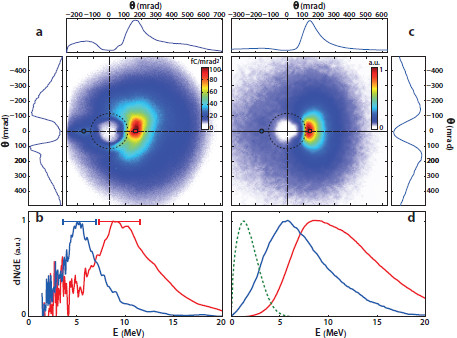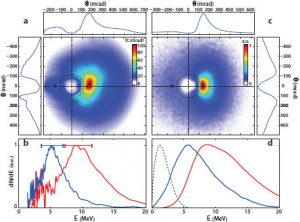Correlated with the harmonic emission and close to the direction of specular reflection, beams of relativistic electrons (≈ 10 MeV energies for I=3.1019 W/cm2, see Fig. 1) are also produced towards the vacuum. There have only been a limited number of experimental investigations of this electron emission in UHI conditions so far [Bra09,Mor09,Tia12], so that the complex underlying mechanisms are not well-understood yet [Gei06,Gei10].
We have recently revealed a crucial feature of this emission [The15]. Electrons are ejected out of the plasma surface in the form of attosecond bunches, with a relativistic velocity along the direction of the specularly reflected laser field. These electrons thus co-propagate with the reflected laser beam in vacuum, and can interact with it over distances on the order of the Rayleigh length. The spatial pattern observed on the electron beam (see figure 6) carries clear signatures of this interaction, and provides some of the most direct evidence so far of processes such as Vacuum Laser Acceleration (VLA, i.e. the direct acceleration of electrons by light in vacuum [Dod03], resulting in the bright peak in the electron beam, next to the specular direction) and relativistic ponderomotive scattering [Ques98] (resulting in the hole in the electron beam around the specular direction). By acting as injectors of electrons in the laser field, with measured charges in the 10 nC range, plasma mirrors thus open the way for the first time to the investigation of the dynamics of free relativistic electrons in ultraintense laser fields. This is a subject of high fundamental interest that has motivated considerable theoretical work in the last decades (e.g. [Har95,Esa95,Yu00,Stu01,Sal06,Pan02,Dod03, Mal03,Var06], but which had so far remained inaccessible experimentally.

Figure 6: Experimental evidence of vacuum laser acceleration. Panel a) shows a typical experimental angular distribution of electrons emitted from plasma mirrors into the vacuum. It consists of a broad emission cone (blue disk), which is strongly modulated by two main patterns. One is a well-defined hole (in white) around the reflected laser beam (whose size and position in the detection plane are indicated by the dashed circle), due to the ponderomotive scattering of electrons after their ejection from the plasma mirror. The other is a bright peak (in red), right on the edge of this hole, due to Vacuum Laser Acceleration of a fraction of these electrons. Panel b) shows the electron spectra measured at two different locations in the beam. These locations are indicated by the blue circle and the red square in panel a), that respectively correspond to the blue and red curves of panel b). Panel c) and d) show the same quantities, now obtained from numerical simulations based on a 3D test particle model. The dashed curve in panel d) shows the initial electron energy distribution used in this model.
[Bra09] Brandl et al, Phys. Rev. Lett. 102, 195001 (2009)
[Dod03] Dodin & Fisch, Phys. Rev. E 68, 056402 (2003)
[Esa95] Esarey et al, Phys. Rev. E 52, 5443 (1995)
[Gei06] Geindre et al, Phys. Rev. Lett. 97, 085001 (2006)
[Gei10] Geindre et al, Phys. Rev. Lett. 104, 135001 (2010)
[Har95] Hartemann et al, Phys. Rev. E 51, 4833 (1995)
[Mal03] Maltsev&Ditmire, Phys. Rev. Lett. 90, 053002 (2003)
[Mor09] Mordovanakis et al, PRL 103, 235001 (2009)
[Pan02] Pang et al, Phys. Rev. E 66, 066501 (2002)
[Ques98] Quesnel &. Mora, Phys. Rev. E 58, 3719 (1998)
[Sal06] Salamin et al, Phys. Rev. A 73, 043402 (2006)
[Stu01] Stupakov et al, Phys. Rev. Lett. 86, 5274 (2001)
[The15] Thévenet et al, submitted to Nature Physics
[Tia12] Tian et al, Phys. Rev. Lett. 109, 115002 (2012)
[Var06] Varin & Piché, Phys. Rev. E 74, 045602 (2006)
[Whe12] Wheeler et al, Nature Photonics 6, 829–833 (2012)


